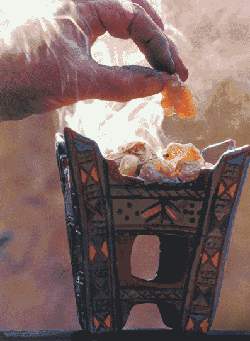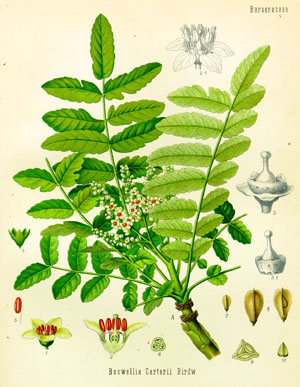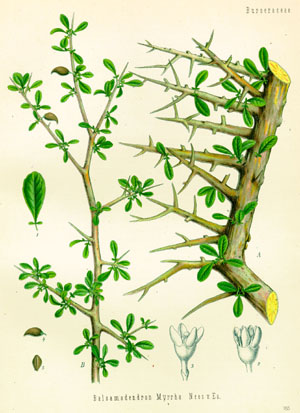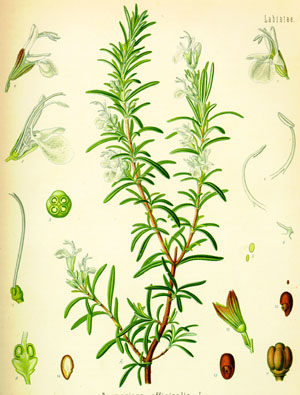Herbs
in Christmas tradition
 Herbs are intricately woven into Christmas
tradition. Several are brought to us directly from the biblical Christmas tale
itself. Myrrh and Frankincense were of course given to the infant Jesus by the
Magi. Other herbs such as Sage, for immortality and domestic
happiness; Lavender, a symbol of purity and virtue; horehound, representitive of giving good
health; rue, as a symbol of grace and also banishes evil; thyme, a symbol of
bravery; and costmary, also called bible leaf, represents everlasting
life- all have also become associated with the holiday. But perhaps the best known herb associated with Christmas is
rosemary. Herbs are intricately woven into Christmas
tradition. Several are brought to us directly from the biblical Christmas tale
itself. Myrrh and Frankincense were of course given to the infant Jesus by the
Magi. Other herbs such as Sage, for immortality and domestic
happiness; Lavender, a symbol of purity and virtue; horehound, representitive of giving good
health; rue, as a symbol of grace and also banishes evil; thyme, a symbol of
bravery; and costmary, also called bible leaf, represents everlasting
life- all have also become associated with the holiday. But perhaps the best known herb associated with Christmas is
rosemary.
Lets take a look to the most common Christmas
herbs to find out more details about them. The three wise men in the story of Christmas carried
gold, frankincense and myrrh. What are frankincense and myrrh?
Frankincense and myrrh are both resins -- dried tree sap -- that come from trees of the genus Boswellia
(frankincense) and Commiphora (myrhh), which are common to
Somalia and Oman.
Frankincense
 |
|
Frankincense
(Boswellia sacra) |
Frankincense was one of the gifts of the
Magi. [Mt 2:11] Tradition says that it was presented to the Christ
Child by Balthasar, the black king from Ethiopia or Saba, thus
fulfilling Isaiah's prophecy that gold and frankincense would be
brought from the Gentiles to honor the heavenly king. [Is 60:6]
Frankincense was the purest incense. When burned it produced a
white smoke which symbolized the prayers and praises of the
faithful ascending to heaven. Because the ancients often burned
frankincense during religious rituals, this gift symbolizes
sacrifice, Christ's divinity, His sweet savor, and His priestly
role. It is also a symbol of the Divine name of God.
Frankincense is a sweet smelling gum
resin derived from certain Boswellia trees which, at the time of
Christ, grew in Arabia, India, and Ethiopia. This gum is known as
frankincense. Its name in other languages is: luban (Arabic), libanos
(Greek), olibanum (Latin), incense (French and German).
The frankincense trade was at its height
during the days of the Roman Empire. At that time this resin was
considered as valuable as gems or precious metals.
Myrrh
 |
|
Myrrh (Commiphora
myrrha) |
Myrrh was another one of the gifts of the
Magi or wise men. [Mt 2:11] Legend says Caspar brought the gift of
myrrh from Europe or Tarsus and placed it before the Christ Child.
Because of myrrh's various medicinal uses this gift represents
Christ's human nature, the Suffering Savior, the Great Physician,
and the Passion.
Myrrh is an
aromatic gum resin which oozes from gashes cut in the bark of a
small desert tree known as Commiphora Myrrha - Balsamodendron
Myrrha or the dindin tree. (The gashes are reminders of the wounds
Christ received while being flogged by the Roman soldiers.) Myrrh was an extremely valuable commodity
during biblical times and was imported from India and Arabia.
Rosemary
 |
|
Rosemary
(Rosmarinus officinalis) |
Rosemary (Rosmarinus
officinalis) is a small perennial evergreen shrub of the mint family
(Laminaceae, or Labiatae) whose leaves are used to flavor foods. Rosemary is steeped in the Christmas
tradition.
Rosemary has been used extensively since 500 b.c. In ancient Greece, it was recognized for its alleged ability to strengthen the brain and
memory.
Several variations of the rosemary legend are told, all of which revolve around Mary the mother of Jesus and her draping of a garment over the rosemary
plant. One version tells that during the Holy Familyís flight to
Egypt, Mary draped the childís garment over a nearby bush- that of the rosemary
shrub. It was sporting its usual white bloom at the time, which then turned blue in honor of the Christ
Child.
A variation of this theme indicates that it was her own cloak, which was blue that was draped over the
shrub. The color blue is traditionally associated with the Holy Mother in the Christian church and some say the flower is blue in deference to
her. Another variation on the theme says that at the time the Christ Childís garments were draped over the bush it was given its pleasant aroma as a reward for providing this service to the
Child.
Perhaps it is this distinctive, memorable scent that gives rosemary its reputation as an herb of
remembrance. It was used at funerals, thrown into the grave and given to the grieved as a sign the deceased would not be
forgotten. It also was woven into the brides wreath at her wedding to remind the participants not to forget their
vows. Thus it also came to represent friendship and fidelity.
|
